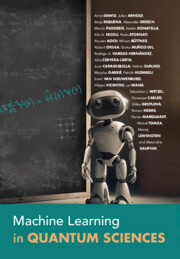Book contents
- Frontmatter
- Dedication
- Contents
- Contributors
- Preface
- Acknowledgments
- Note on the text
- Abbreviations
- 1 Introduction
- 2 Basics of machine learning
- 3 Phase classification
- 4 Gaussian processes and other kernel methods
- 5 Neural-network quantum states
- 6 Reinforcement learning
- 7 Deep learning for quantum sciences: Selected topics
- 8 Physics for deep learning
- 9 Conclusion and outlook
- A Mathematical details on principal component analysis
- B Derivation of the kernel trick
- C Choosing the kernel matrix as the covariance matrix for a Gaussian process
- References
- Index
8 - Physics for deep learning
Published online by Cambridge University Press: 13 June 2025
- Frontmatter
- Dedication
- Contents
- Contributors
- Preface
- Acknowledgments
- Note on the text
- Abbreviations
- 1 Introduction
- 2 Basics of machine learning
- 3 Phase classification
- 4 Gaussian processes and other kernel methods
- 5 Neural-network quantum states
- 6 Reinforcement learning
- 7 Deep learning for quantum sciences: Selected topics
- 8 Physics for deep learning
- 9 Conclusion and outlook
- A Mathematical details on principal component analysis
- B Derivation of the kernel trick
- C Choosing the kernel matrix as the covariance matrix for a Gaussian process
- References
- Index
Summary
In this chapter, we change our viewpoint and focus on how physics can influence machine learning research. In the first part, we review how tools of statistical physics can help to understand key concepts in machine learning such as capacity, generalization, and the dynamics of the learning process. In the second part, we explore yet another direction and try to understand how quantum mechanics and quantum technologies could be used to solve data-driven task. We provide an overview of the field going from quantum machine learning algorithms that can be run on ideal quantum computers to kernel-based and variational approaches that can be run on current noisy intermediate-scale quantum devices.
Information
- Type
- Chapter
- Information
- Machine Learning in Quantum Sciences , pp. 221 - 253Publisher: Cambridge University PressPrint publication year: 2025
